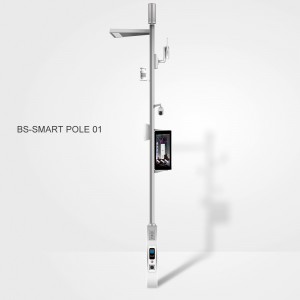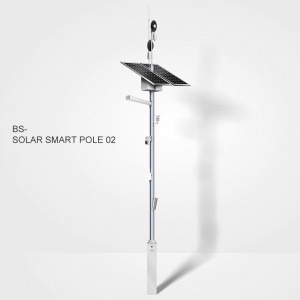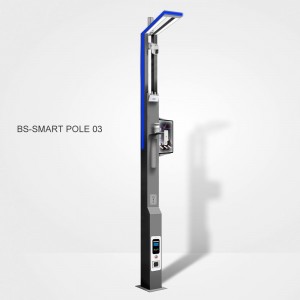Manage and Collect the Data of Smart Poles for City Management
With the development of smart cities, information technology means are widely used in public services, urban governance and smart transportation. As an important infrastructure of smart cities, smart light poles play a key role in urban big data collection. However, during the implementation and application of a large number of smart light pole projects, some new problems have emerged. First, as the number of city-level smart light poles usually reaches tens of thousands, it is difficult to accurately manage the factory configurations, installation locations, and equipment information loading of the light poles by traditional manual methods. Moreover, the long life cycle of smart light poles and the involvement of multiple units have brought great difficulties in the accurate and efficient maintenance of the equipment.
Second, individual light poles are loaded with a wide variety of sensors of different brands and specifications. These sensors generate a large amount of dynamically updated data, including light pole condition data, environmental data, and camera video data, etc. How to effectively manage the data collected from light poles to serve the smart city domain is a current challenge. How to effectively manage the data collected by the light poles so that it can serve the smart city field has become a current challenge. If we cannot accurately manage the smart light poles and the data they collect, we cannot give full play to the role of smart light poles in smart city management, smart transportation and smart parks, which will become a bottleneck in the development of the smart light pole industry. This article examines the primary challenges of deploying smart pole technology and how effective smart city data management can unlock the value of these systems, enabling cities to transition from traditional lighting to intelligent, responsive infrastructure.
Smart Poles as the Backbone of Smart City
Smart pole technology blends smart outdoor lighting with IoT-powered features, enabling cities to illuminate streets while collecting valuable data. Acting as urban sentinels, these poles contribute to:
Smart city data management
Traffic monitoring and control
Environmental sensing
Emergency response coordination
Public Wi-Fi and digital signage delivery
Why Accurate Data Matters in Smart City Operations
The data collected by smart streetlight poles is the foundation of intelligent urban services. From lighting schedules and environmental readings to traffic flow and public safety, this data feeds the broader smart city lighting system and supports citywide decision-making. Without accuracy and structure, data becomes noise, not knowledge.
Key reasons why accurate data is critical:
Operational Efficiency: Reliable data ensures correct lighting levels, proactive maintenance, and optimized energy use for smart outdoor lights.
Real-Time Response: Emergency systems, such as one-touch alarms or camera alerts on smart poles, require immediate and accurate data transmission.
Urban Planning Insights: Environmental sensors, foot traffic counters, and air quality monitors help urban planners make informed, data-driven decisions.
Integrated Services: Accurate data allows seamless coordination across departments—connecting public safety, transportation, utilities, and more.
Pain Point Analysis in Real-World Deployments
Despite their advantages, real-world smart city street lighting deployments are not without their obstacles. Two major categories of pain points are emerging in large-scale smart pole rollouts:
1) Massive Scale and Lifecycle Complexity
With city-level deployments involving tens of thousands of smart street light poles, traditional manual methods of tracking factory configurations, installation positions, and module specifications are insufficient. The challenge is amplified by the long life cycles of these poles and the involvement of multiple manufacturers, contractors, and maintenance units.
Result:
Poor coordination, misaligned records, and ineffective maintenance strategies.
2) Sensor Diversity and Data Overload
Each smart pole may carry a variety of sensors and devices from different vendors, ranging from light sensors and air quality monitors to surveillance cameras and charging stations. These components produce continuously updated data: pole health, environmental conditions, traffic patterns, and even real-time video feeds.
Challenge:
Without a robust smart city data management platform, cities face the risk of fragmented, underutilized data streams—preventing effective service delivery and decision-making.
The Crucial Role of a Smart City Control System
To address these problems, a reliable and intelligent smart city control system becomes indispensable. Here’s how it solves core pain points:
Accurate Asset and Configuration Management
Centralized registration of every smart pole’s location, specification, and operating status
Real-time tracking of component lifecycles and maintenance history
Unified Data Integration and Visualization
Aggregates dynamic data from diverse sources (e.g., lighting conditions, air quality, real-time video feeds)
Enables cross-departmental sharing to support smart city functions like traffic optimization and emergency response
Predictive Maintenance and Operational Efficiency
AI-powered diagnostics detect faults early, minimizing downtime
Maintenance schedules are optimized based on real-time performance data
Scalable Modular Expansion
New modules (e.g., EV chargers, LED screens, weather stations) can be added seamlessly as urban needs evolve
Supporting Smart City Applications
With accurate, managed data, smart cities connect all layers of service and infrastructure. This enables:
Predictive Maintenance: AI and analytics predict component failures before they happen, minimizing downtime and maintenance costs.
Energy Optimization: Adaptive lighting based on ambient light, motion detection, or traffic patterns reduces waste and saves money.
Public Safety Enhancements: Live video, environmental alerts, and smart alarms support rapid emergency responses.
Scalable Growth: As cities expand, new modules and poles can be integrated easily without disrupting the system—supporting future smart city trends.
Post time: Jul-28-2025





